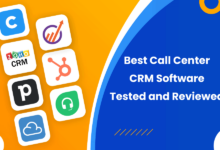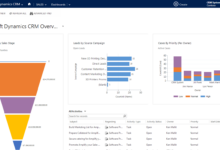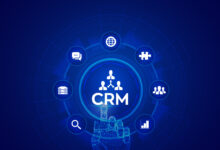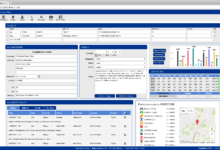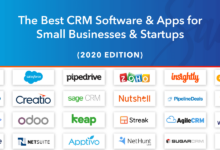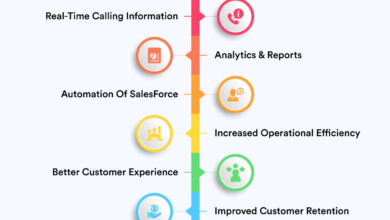Landscape CRM: A Comprehensive Guide
Landscape CRM, a revolutionary approach to customer relationship management, moves beyond traditional systems by offering a more holistic and integrated view of customer interactions. This approach recognizes the complexity of modern business relationships, encompassing not just individual customers but also their interactions across various channels and touchpoints. Understanding the nuances of landscape CRM is crucial for businesses seeking to optimize customer engagement and drive sustainable growth.
This guide delves into the core features, implementation strategies, and future trends of landscape CRM, providing a detailed overview for businesses considering its adoption. We’ll explore the benefits and challenges, comparing it to traditional CRM systems and offering practical advice for successful implementation.
Defining Landscape CRM
Landscape CRM represents a specialized type of customer relationship management (CRM) system designed specifically for businesses operating within the landscaping and green industry sectors. Unlike traditional CRM systems that offer generic contact management and sales tracking, Landscape CRM solutions incorporate functionalities tailored to the unique needs and workflows of landscaping companies. These systems go beyond basic contact information, integrating features relevant to project management, equipment tracking, and service scheduling, leading to increased operational efficiency and improved customer relationships.
This specialized CRM offers a significant advantage over generic systems by providing tools directly relevant to the landscaping industry’s specific operational challenges and opportunities. It allows businesses to manage various aspects of their operations more efficiently, from initial client contact to project completion and ongoing maintenance. This integration streamlines processes and provides a holistic view of the business, improving decision-making and ultimately increasing profitability.
Key Characteristics and Functionalities of Landscape CRM
Landscape CRM systems are characterized by a suite of features designed to address the specific needs of landscaping businesses. These features go beyond the basic contact management and sales pipeline tracking found in general-purpose CRM solutions. Crucially, they are built to handle the unique data and processes inherent in landscaping operations.
- Job Scheduling and Dispatching: These systems often include tools for scheduling and dispatching crews, optimizing routes, and tracking job progress in real-time. This improves efficiency and reduces travel time.
- Equipment Management: Tracking equipment maintenance schedules, location, and operational status is crucial for landscaping businesses. Landscape CRMs often include modules for this purpose, minimizing downtime and maximizing asset utilization.
- Project Management: From initial client consultation to project completion, these systems provide tools for managing project timelines, budgets, and resources, ensuring projects stay on track and within budget.
- Customer Portal: Many Landscape CRMs include a customer portal allowing clients to access information about their projects, communicate with the company, and make payments, improving communication and client satisfaction.
- Invoicing and Payment Processing: Streamlined invoicing and payment processing capabilities are essential. These systems often integrate with accounting software for seamless financial management.
- Reporting and Analytics: Landscape CRMs provide robust reporting and analytics dashboards, allowing businesses to track key performance indicators (KPIs) such as job profitability, customer retention, and equipment utilization.
Types of Businesses Benefiting from Landscape CRM
A wide range of businesses within the landscaping and green industry can significantly benefit from implementing a Landscape CRM system. The effectiveness of the system scales with the size and complexity of the business.
- Residential Landscaping Companies: Even smaller residential landscaping businesses can benefit from improved scheduling, communication, and client management.
- Commercial Landscaping Companies: Larger commercial operations with multiple crews and complex projects will see substantial improvements in efficiency and project management.
- Arborists and Tree Care Services: Companies specializing in tree care can use the system to manage client trees, scheduling, and maintenance contracts.
- Irrigation Companies: Irrigation companies can utilize the system to manage client properties, scheduling maintenance visits, and tracking system performance.
- Lawn Care Services: Companies providing lawn care services can use the system to manage recurring services, track customer preferences, and schedule treatments efficiently.
Landscape CRM Features and Functionality
Landscape CRM software offers a range of features designed to streamline business processes and improve efficiency for landscaping companies. These features go beyond basic contact management, encompassing project management, resource allocation, and financial tracking, all tailored to the specific needs of the landscaping industry. The selection of the right system depends heavily on the size and complexity of the business, as well as its specific operational requirements.
Comparison of Landscape CRM Solutions
The following table compares the core features of three hypothetical Landscape CRM solutions – GreenThumb CRM, LeafLogic, and BloomBoost – to illustrate the range of functionalities available on the market. Feature availability and specific capabilities may vary depending on the chosen pricing plan and version.
| Feature | GreenThumb CRM | LeafLogic | BloomBoost |
|---|---|---|---|
| Data Integration (with accounting software, scheduling apps, etc.) | Integrates with QuickBooks and popular scheduling apps. Offers API for custom integrations. | Integrates with Xero and several popular scheduling and mapping tools. Limited custom integration options. | Offers robust API and pre-built integrations with a wide range of accounting and scheduling software. |
| Reporting Capabilities (project profitability, client retention, resource utilization) | Provides standard reports on project profitability, client retention, and basic resource utilization. Custom reporting requires additional cost. | Offers a wider array of pre-built reports, including detailed resource utilization analysis. Limited custom reporting options. | Highly customizable reporting dashboards, allowing for in-depth analysis across all key metrics. Includes data visualization tools. |
| Mobile Accessibility (iOS and Android) | Offers mobile apps for both iOS and Android, providing access to key features on the go. | Provides mobile-optimized website access; dedicated apps are planned for future release. | Fully functional mobile apps for iOS and Android, mirroring the desktop experience. Offline access to critical data. |
| Customer Relationship Management (CRM) Features (contact management, communication tools) | Standard CRM features including contact management, task assignment, and basic communication tools. | Enhanced CRM features with integrated communication tools, including email marketing and SMS capabilities. | Advanced CRM features with robust communication tools, including automated email sequences and integrated customer support ticketing. |
Handling Complex Data Sets and Relationships
Landscape CRM systems effectively manage complex data sets by employing relational database structures. This allows for the linking of various data points, such as client information, project details, employee schedules, material costs, and equipment usage. For instance, a system can easily track the materials used on a specific project for a particular client, linking that data to the project’s overall budget and profitability. The relational nature ensures data integrity and facilitates comprehensive reporting and analysis. Relationships between entities are established through unique identifiers, enabling efficient data retrieval and manipulation. For example, a client ID can be linked to multiple projects, each with its own associated tasks, materials, and invoices.
Automation in Landscape CRM
Automation plays a crucial role in enhancing efficiency and reducing manual effort within Landscape CRM. Automated workflows streamline repetitive tasks, freeing up valuable time for more strategic activities. Examples of automated workflows include:
* Automated appointment reminders: The system automatically sends email or SMS reminders to clients about upcoming appointments, reducing no-shows and improving scheduling efficiency.
* Automated invoice generation: Upon project completion, the system automatically generates invoices based on pre-defined pricing and tracked expenses.
* Automated follow-up emails: After a project is completed, the system automatically sends follow-up emails to clients, requesting feedback and soliciting future business.
* Automated reporting: The system generates regular reports on key performance indicators (KPIs), such as project profitability and client retention, without manual intervention.
Implementation and Integration of Landscape CRM
Successfully implementing a Landscape CRM system requires careful planning and execution. A phased approach, focusing on user training and data migration, minimizes disruption and maximizes the return on investment. This section details a practical implementation plan and addresses potential challenges.
Step-by-Step Implementation Plan
A phased approach ensures a smooth transition and minimizes disruption to ongoing business operations. This plan outlines key steps for a hypothetical business adopting a Landscape CRM system.
- Needs Assessment and System Selection: Begin by thoroughly assessing your business’s specific needs and requirements. This involves identifying key pain points, desired functionalities, and the number of users. Based on this assessment, select a Landscape CRM system that aligns with your budget and capabilities. Consider factors like scalability, integration capabilities, and user-friendliness.
- Data Migration Strategy: Develop a comprehensive data migration plan. This involves identifying data sources, cleaning and transforming data to ensure consistency and accuracy, and establishing a secure method for transferring data to the new system. Consider using specialized data migration tools to streamline this process.
- System Configuration and Customization: Configure the chosen Landscape CRM system to meet your specific needs. This may involve customizing workflows, dashboards, and reports. Consider involving key users in this process to ensure the system is intuitive and meets their requirements.
- User Training and Support: Provide comprehensive training to all users. This should cover basic functionalities, advanced features, and troubleshooting techniques. Establish a support system to address user queries and provide ongoing assistance.
- Go-Live and Post-Implementation Review: After the system is fully configured and users are trained, launch the system. Conduct a post-implementation review to assess the effectiveness of the implementation and identify areas for improvement. This review should include feedback from users and key stakeholders.
Challenges During Integration and Potential Solutions
Integrating a new CRM system can present several challenges. Proactive planning and mitigation strategies are crucial for a successful transition.
- Data Migration Issues: Inconsistent or incomplete data can hinder the accuracy and effectiveness of the new system. Solution: Implement a robust data cleansing and transformation process before migration. This may involve data validation, standardization, and deduplication.
- Integration with Existing Systems: Seamless integration with existing software (accounting, scheduling, etc.) is essential. Solution: Choose a Landscape CRM system with strong API capabilities and engage experienced integration specialists to ensure compatibility.
- User Adoption Resistance: Employees may resist adopting a new system due to unfamiliarity or perceived complexity. Solution: Provide comprehensive training, clear communication, and ongoing support. Address user concerns and actively solicit feedback.
- Data Security Concerns: Protecting sensitive customer data is paramount. Solution: Implement robust security measures, including access controls, data encryption, and regular security audits. Ensure compliance with relevant data privacy regulations.
Best Practices for Data Migration
Effective data migration is critical for a successful CRM implementation. These best practices minimize disruption and ensure data accuracy.
Before initiating the migration, a thorough data audit is crucial. This involves identifying data sources, assessing data quality, and defining data mapping rules. This ensures a clean and accurate transfer of information to the new system. A phased approach, migrating data in manageable chunks, allows for easier monitoring and correction of any errors. Regular backups throughout the process safeguard against data loss. Post-migration validation is essential to confirm data integrity and identify any discrepancies.
Benefits and Challenges of Using Landscape CRM
Implementing a Landscape CRM system offers significant potential for streamlining business operations and enhancing customer relationships. However, like any technological adoption, it presents certain challenges that need careful consideration. Understanding both the advantages and disadvantages is crucial for making an informed decision.
Key Benefits of Landscape CRM
Landscape CRM systems offer a range of benefits that contribute to increased efficiency and profitability. These advantages stem from improved data management, enhanced communication, and more effective resource allocation.
- Improved Customer Relationship Management: Centralized customer data provides a 360-degree view, allowing for personalized service and targeted marketing campaigns. This leads to stronger customer loyalty and increased retention rates. For example, a landscaping company can track client preferences for specific plant types, allowing them to proactively offer relevant services or products.
- Enhanced Operational Efficiency: Automation of tasks such as scheduling, invoicing, and communication frees up valuable time for staff to focus on core business activities. This leads to reduced operational costs and improved productivity. A landscaping business could automate appointment reminders, reducing no-shows and improving time management.
- Better Resource Management: Real-time tracking of projects, equipment, and personnel allows for optimized resource allocation, minimizing downtime and maximizing profitability. Imagine a landscape company using the CRM to track the location and availability of their crews and equipment, ensuring optimal assignment for each project.
- Data-Driven Decision Making: Comprehensive data analysis provides valuable insights into customer behavior, project performance, and operational efficiency. This allows businesses to make informed decisions based on concrete data rather than intuition. For instance, a landscape company could analyze customer data to identify popular service packages and adjust their offerings accordingly.
Challenges of Landscape CRM Adoption
While the benefits of Landscape CRM are substantial, several challenges can hinder successful implementation and adoption. These challenges often relate to cost, integration, and user adoption.
- Implementation Costs: The initial investment in software, hardware, training, and integration can be significant, especially for smaller businesses. This includes not only the software license but also the time and resources needed for setup and training.
- Data Migration and Integration: Transferring existing customer data from legacy systems can be complex and time-consuming. Integrating the CRM with other business systems, such as accounting software, also requires careful planning and execution. Inconsistencies in data format can present significant hurdles.
- User Adoption and Training: Successful CRM implementation depends on user buy-in and proper training. Resistance to change and inadequate training can lead to low adoption rates and ultimately hinder the realization of benefits.
- System Complexity and Customization: Some Landscape CRM systems can be complex to navigate and require significant customization to meet the specific needs of a business. This can increase implementation time and cost.
Total Cost of Ownership (TCO) Comparison
The total cost of ownership for Landscape CRM varies greatly depending on the specific software chosen, the size of the business, and the level of customization required. Generally, cloud-based Landscape CRM solutions tend to have a lower TCO compared to traditional on-premise systems due to reduced infrastructure costs and maintenance. However, the ongoing subscription fees need to be factored in. A detailed cost-benefit analysis, comparing the potential return on investment (ROI) against the TCO, is crucial before making a decision. This analysis should consider factors like increased efficiency, reduced operational costs, and improved customer retention. Traditional CRM systems, while potentially offering more control, often incur higher upfront costs for hardware, software licenses, and ongoing maintenance.
Future Trends in Landscape CRM
The landscape of landscape management is constantly evolving, driven by technological advancements and shifting customer expectations. This necessitates a parallel evolution in the CRM systems used to manage client relationships, operations, and business growth. The coming years will see significant changes in how landscape companies leverage technology to improve efficiency, enhance customer experience, and gain a competitive edge.
The integration of Artificial Intelligence (AI) and machine learning (ML) will be a defining factor in the future of Landscape CRM. These technologies will not only automate repetitive tasks but also provide predictive analytics to optimize resource allocation and improve decision-making.
AI-Powered Predictive Maintenance
AI algorithms can analyze historical data on equipment usage, maintenance schedules, and environmental factors to predict potential equipment failures. This allows for proactive maintenance, minimizing downtime and reducing repair costs. For example, a system could predict when a specific mower will require a blade sharpening based on its usage patterns and environmental conditions, sending an alert to the maintenance team well in advance. This proactive approach significantly reduces unexpected breakdowns and improves operational efficiency.
Enhanced Customer Relationship Management (CRM) through AI
AI-powered chatbots and virtual assistants can handle routine customer inquiries, freeing up human staff to focus on more complex tasks and building stronger relationships with clients. Furthermore, AI can analyze customer data to identify patterns and preferences, allowing for personalized marketing campaigns and targeted service offerings. Imagine a system automatically sending a personalized email to a client reminding them of their upcoming lawn care service based on their historical schedule and preferred communication method. This level of personalization enhances customer satisfaction and loyalty.
Integration with IoT Devices and Sensors
The Internet of Things (IoT) will play a crucial role in enhancing the data collection capabilities of Landscape CRMs. Sensors embedded in equipment, vehicles, and even within the landscape itself (soil moisture sensors, for example) can provide real-time data on various parameters. This data can then be integrated into the CRM to provide a holistic view of operations and optimize resource management. For instance, soil moisture sensors could alert the system when a specific area needs watering, automatically scheduling irrigation and optimizing water usage.
Blockchain Technology for Enhanced Security and Transparency
Blockchain technology offers the potential to enhance security and transparency within Landscape CRMs. It can be used to securely store and manage sensitive client data, ensuring data integrity and preventing unauthorized access. Additionally, it can be used to track materials, equipment, and services throughout the supply chain, providing a transparent and auditable record of all transactions. This improves accountability and builds trust with clients.
Improved Mobile Accessibility and User Experience
Future Landscape CRMs will prioritize mobile accessibility and user experience. Intuitive interfaces and mobile-optimized features will enable field staff to access and update information in real-time, improving communication and coordination. Imagine a system allowing landscape technicians to update job completion statuses, capture photos of completed work, and access client information directly from their smartphones in the field. This streamlining of workflows increases efficiency and accuracy.
Potential Future Enhancements
The following list outlines potential future enhancements to Landscape CRMs based on current industry developments:
- Integration with drone technology for aerial surveys and data collection.
- Advanced analytics dashboards providing real-time insights into key performance indicators (KPIs).
- Automated invoicing and payment processing systems.
- Enhanced reporting and analytics capabilities to track profitability and efficiency.
- Seamless integration with other business software, such as accounting and payroll systems.
Case Studies of Successful Landscape CRM Implementations
Real-world examples demonstrate the transformative power of Landscape CRM in various sectors. Analyzing these successes reveals common themes and highlights the significant benefits achievable through strategic implementation. This section presents a fictional case study illustrating a successful implementation within the horticultural industry, focusing on challenges, solutions, and positive outcomes.
GreenThumb Gardens: A Case Study in Horticultural CRM Success
GreenThumb Gardens, a medium-sized landscaping company specializing in residential and commercial projects, faced significant challenges managing its customer relationships. Their existing system relied on spreadsheets and email, leading to inconsistent communication, missed deadlines, and difficulty tracking project progress and client preferences. This resulted in decreased client satisfaction and lost revenue opportunities. To address these issues, GreenThumb Gardens implemented a Landscape CRM solution tailored to their specific needs. The chosen solution included features such as client relationship management, project management tools, inventory tracking, and automated communication capabilities. The system allowed for centralizing all client information, improving communication efficiency, and providing real-time project updates. The result was a significant increase in customer satisfaction, improved operational efficiency, and a substantial boost in profitability. Specifically, client retention increased by 15% within the first year, and project completion times were reduced by 10%.
Visual Representation of Improved Customer Relationship Management
A visual representation of GreenThumb Gardens’ improved CRM could be a before-and-after comparison chart. The “before” chart would depict a disorganized network of scattered data points (representing clients, projects, and communications) with numerous overlapping lines indicating confusion and inefficient communication. The chart would be visually cluttered, reflecting the chaos of their previous system. The “after” chart, in contrast, would show a streamlined, interconnected network of data points. Clear lines would connect clients to their respective projects and communications, demonstrating efficient workflow and improved communication clarity. The color-coding of data points could highlight different project phases or client segments, illustrating improved organization and the ability to segment and target customers effectively. The overall visual impact would convey a clear transformation from a disorganized and inefficient system to a well-structured and efficient one. This visual comparison would clearly illustrate the positive impact of the Landscape CRM implementation on GreenThumb Gardens’ customer relationship management.
Closure
In conclusion, Landscape CRM represents a significant advancement in customer relationship management, offering businesses the tools to navigate the complexities of modern interactions. While challenges exist, the potential benefits—from improved customer engagement to enhanced operational efficiency—make it a compelling solution for organizations seeking to gain a competitive edge. By carefully considering implementation strategies and leveraging the insights provided in this guide, businesses can successfully harness the power of landscape CRM to achieve their strategic objectives.
